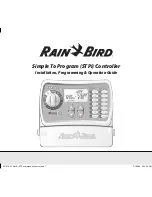
Commissioning
Upon completion of the installation, the valve should be tested and commissioned as per the
procedure outlined below or as specified by the local authority.
The following instructions should be read and understood prior to commissioning the Caleffi 5213
series thermostatic mixing valve. If, under any circumstances, there are aspects of the installation/
system which do not comply with our requirements or the specifications as listed, the valve must
not be put into service until the installation/system does comply.
1) Ensure that the system is throughly clean and free from debris prior to commissioning the
thermostatic mixing valve.
2) Use a suitably califbrated and accurate digital thermometer to comission temperatures.
The valve is commissioned by measuring the mixed water temperature at the outlet.
3) In accordance with the anti-scald requirements, water installation shall deliver hot water at
the outlet of the sanitary fixtures used primarily for personal hygiene purposes at a
temperature not exceeding:
· 120°F (49°C) or as specified by authority having jurisdiction.
4) The temperature at the outlet of each valve must be set taking into consideration any
fluctuations which may occur within the system due to simultaneous demand.
5) Once the supply temperatures are stabilized and the normal operating conditions are
established, the valve can be commissioned. Due to the unique design of the cap, the
temperature setting can be adjusted by removing the cap from the valve body and
reversing the cap onto the temperature adjustment spindle. Use the following sequence when
commissioning the valve.
a) Set the mixed water discharge temperature to the required temperature.
b) Measure and record the temperature of hot and cold water supplies at the
connections to the valve.
c) Measure and record the temperature of the water discharging from the largest and
smallest volume draw off points.
d) Perform the thermal shut-off test. Isolate the cold water supply to the Caleffi valve
and monitor the mixed water temperature. The outlet flow should quickly cease
flowing.
e) Measure and record the maximum mixed water temperature. The temperature
should not exceed the temperature allowed by the applicable standard or code of
practice for each state.
f) Restore the cold water supply to the valve and measure and record the outlet
temperature after the mixed water temperature has stabilized. The final temperature
found during this test should not exceed the permitted 3°F.
6) Once the desired temperature has been reached, the adjustment spindle can be locked in
position using the locking nut supplied with the valve.
7) Once the desired temperature is established, remove the cap from the temperature
adjustment spindle and secure the head back on to the valve into its original position to
prevent tampering by unauthorised persons.
We recommend that the above information is recorded in the Commissioning Report and updated
on the Service Report when any work is performed on the valve.
11


































